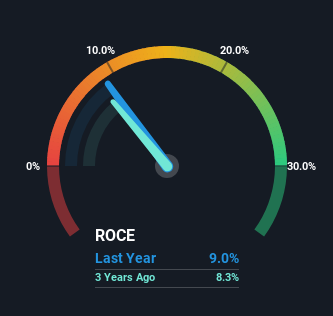- United States
- /
- Healthcare Services
- /
- NYSE:MD
We Like These Underlying Return On Capital Trends At Pediatrix Medical Group (NYSE:MD)

If we want to find a potential multi-bagger, often there are underlying trends that can provide clues. One common approach is to try and find a company with returns on capital employed (ROCE) that are increasing, in conjunction with a growing amount of capital employed. Ultimately, this demonstrates that it's a business that is reinvesting profits at increasing rates of return. Speaking of which, we noticed some great changes in Pediatrix Medical Group's (NYSE:MD) returns on capital, so let's have a look.
What Is Return On Capital Employed (ROCE)?
For those who don't know, ROCE is a measure of a company's yearly pre-tax profit (its return), relative to the capital employed in the business. The formula for this calculation on Pediatrix Medical Group is:
Return on Capital Employed = Earnings Before Interest and Tax (EBIT) ÷ (Total Assets - Current Liabilities)
0.09 = US$152m ÷ (US$2.0b - US$310m) (Based on the trailing twelve months to June 2024).
So, Pediatrix Medical Group has an ROCE of 9.0%. On its own, that's a low figure but it's around the 10% average generated by the Healthcare industry.
View our latest analysis for Pediatrix Medical Group

Above you can see how the current ROCE for Pediatrix Medical Group compares to its prior returns on capital, but there's only so much you can tell from the past. If you'd like, you can check out the forecasts from the analysts covering Pediatrix Medical Group for free.
So How Is Pediatrix Medical Group's ROCE Trending?
Pediatrix Medical Group has not disappointed in regards to ROCE growth. The figures show that over the last five years, returns on capital have grown by 51%. The company is now earning US$0.09 per dollar of capital employed. Interestingly, the business may be becoming more efficient because it's applying 68% less capital than it was five years ago. If this trend continues, the business might be getting more efficient but it's shrinking in terms of total assets.
The Key Takeaway
From what we've seen above, Pediatrix Medical Group has managed to increase it's returns on capital all the while reducing it's capital base. Astute investors may have an opportunity here because the stock has declined 50% in the last five years. That being the case, research into the company's current valuation metrics and future prospects seems fitting.
One more thing to note, we've identified 3 warning signs with Pediatrix Medical Group and understanding them should be part of your investment process.
While Pediatrix Medical Group may not currently earn the highest returns, we've compiled a list of companies that currently earn more than 25% return on equity. Check out this free list here.
New: Manage All Your Stock Portfolios in One Place
We've created the ultimate portfolio companion for stock investors, and it's free.
• Connect an unlimited number of Portfolios and see your total in one currency
• Be alerted to new Warning Signs or Risks via email or mobile
• Track the Fair Value of your stocks
Have feedback on this article? Concerned about the content? Get in touch with us directly. Alternatively, email editorial-team (at) simplywallst.com.
This article by Simply Wall St is general in nature. We provide commentary based on historical data and analyst forecasts only using an unbiased methodology and our articles are not intended to be financial advice. It does not constitute a recommendation to buy or sell any stock, and does not take account of your objectives, or your financial situation. We aim to bring you long-term focused analysis driven by fundamental data. Note that our analysis may not factor in the latest price-sensitive company announcements or qualitative material. Simply Wall St has no position in any stocks mentioned.
About NYSE:MD
Pediatrix Medical Group
Provides newborn, maternal-fetal, and other pediatric subspecialty care services in the United States.
Good value with adequate balance sheet.
Similar Companies
Market Insights
Community Narratives




